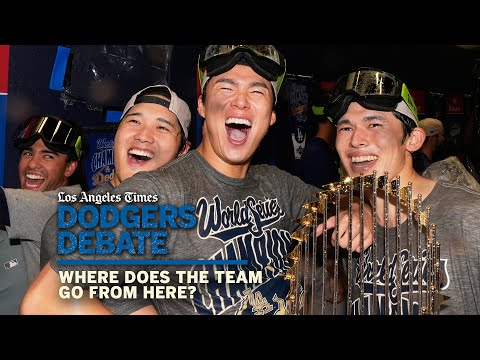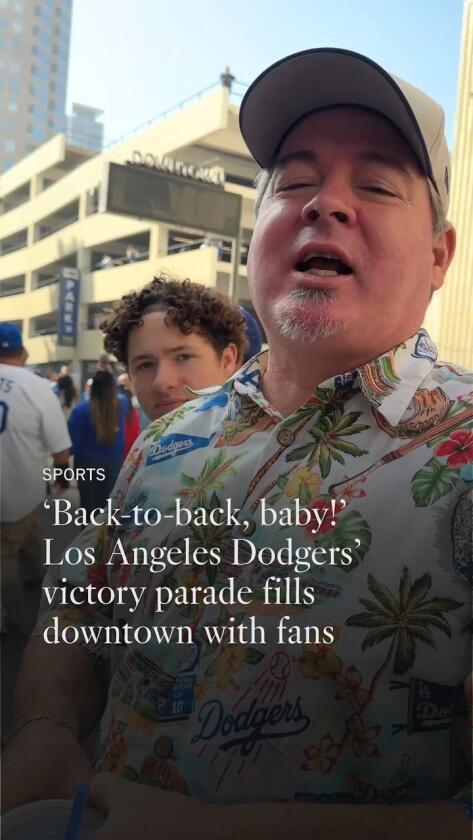Dodgers pick up club option on Max Muncy, retaining key part of roster
The now two-time defending World Series champion Dodgers made their first move of the offseason on Thursday.
It will ensure a familiar face is back for their pursuit of a three-peat next year.
The team picked up its $10-million club option for third baseman Max Muncy, according to a person with knowledge of the situation not authorized to speak publicly, bringing the now longest-tenured member of the roster back for what will be his ninth season in Los Angeles.

The decision was not surprising. This year, Muncy had perhaps his best all-around season at the plate since a 2021 campaign in which he received MVP votes. He hit .243, his highest mark since that 2021 season, with 19 home runs, 67 RBIs and an .846 OPS in 100 games. He atoned for a relatively quiet postseason by hitting a crucial home run in the eighth inning of Game 7 of the World Series, setting the stage for the team’s ninth-inning comeback and eventual extra-innings, title-clinching victory.
Muncy was in the final season of a two-year, $24-million extension he signed in the 2023 offseason. And injuries have been a problem for the 35-year-old in recent years (he was limited this past season by a knee contusion in July and an oblique strain in August).
However, the $10-million option was a relative bargain for a player who, prior to second-half injuries, had shaken off a slow start to the year by being one of the hottest hitters in the majors in May and June.
His return will also help keep a key part of the club’s veteran core intact, bringing back a player who — in the wake of Clayton Kershaw’s retirement — has been with the Dodgers longer than anybody else.
Muncy’s 2025 season did not start well. After an offseason in which trade rumors involving Nolan Arenado swirled, and a spring training spent working through the lingering after-effects of an oblique and rib injury that limited him in 2024, Muncy hit .176 through his first 34 games, and had only one home run.
In early May, however, he started wearing glasses to address an astigmatism in his right eye. Around that same time, he also found a breakthrough with his swing, one that helped him begin punishing fastballs up the zone. From May 7 to the end of June, he hit .315 with 12 home runs and a 1.039 OPS, one of the best stretches of his 10-year, two-time All-Star career.
That streak was derailed on July 2, when Muncy suffered his knee injury after being slid into at third base. His return a month later was cut short, too, when his oblique began bothering him during a batting practice session in August.
Those IL stints preceded a September slump that carried into the postseason, when Muncy hit just .173 entering Game 7 of the World Series.
But that night, he collected three hits, had the pivotal eighth-inning home run off Trey Yesavage that got the Dodgers back within a run, and became one of six players to contribute to all three of the Dodgers’ recent World Series titles.
“It’s starting to get a little bit comfortable up here,” he joked from atop the stage at the Dodgers’ World Series celebration on Monday. “Let’s keep it going.”
On Thursday, the team ensured his run with the Dodgers will, for at least one more season.
Alex Vesia’s option also picked up
The Dodgers on Thursday also picked up their $3.55-million club option for reliever Alex Vesia in 2026, according to multiple people with knowledge of the situation not authorized to speak publicly. That was also not a surprise, though Vesia still would’ve been under team control and eligible for arbitration if they hadn’t.
Vesia was one of the few consistent performers in the Dodgers’ bullpen this year, posting a 3.02 ERA in a career-high 68 appearances. He was also one of their most trusted relief arms in the playoffs, bouncing back from a two-run outing in the wild-card series opener with 4 ⅓ scoreless innings the rest of the way.
Vesia was not available for the World Series as he and his wife dealt with what the team described as a “deeply personal family matter.” But he figures to be a key cog in their bullpen again next season, in what will be his last before reaching free agency.

